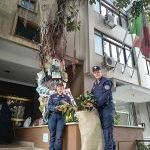A Tree for the Future
'A Tree for the Future' is a national environmental education project aimed at schools on the importance of trees, biodiversity and conservation. It is promoted by the Ministry of Ecological Transition and the Carabinieri of Biodiversity. The project encourages everyone to plant a tree to create a national forest of native species. A digital map on the project website identifies the places where the trees have been planted, together with infomation about the number of trees, participants and CO2 stored by the trees.
Website
Useful links
The Woodland Trust in the UK supports schools with growing trees in their grounds
Country
Media
* TOP TIP *
'Most schools will be able to find space to plant at least one small tree in their grounds. Select a native species, but check on whether it suits your soil and climate, and how big it will grow when mature!'
How is the project linked to climate change and sustainability?
Trees are very important with respect to climate change as they absorb and store CO2 which is a key 'greenhouse gas'. Trees also provide valuable habitats for wildlife and provide shade, shelter and reduce flood risks. This project is linked to climate change and sustainability because the project aims to increase the green area and the consequent saving of carbon dioxide.
Who is involved?
The project is aimed at both primary and secondary schools with the Carabinieri of Biodiversity offering support to teachers and pupils in running the project.
How are the participants involved?
The total duration of the project is three years with a goal to acheive by the end of the school year. Schools apply online to join the project and promise to look after the tree seedlings. They can choose from a variety of native species on the website, and details are given about how to care for them.
Every year there are at least two meetings in the classroom and a visit of the class to a discovery centre of the Carabinieri of Biodiversity. During the classroom meetings, Carabinieri Forestale staff will enable the students to learn about the characteristics of the surrounding environments and encouraging the children to actively do something to improve the environmental quality, even in those areas that are not 'green'.
Students will be able to check progress on a digital map that will identify the places where the trees have been planted. At the end of the three years, the map will be the concrete result of the commitment of the students and the Carabinieri of Biodiversity to increase the green surface and the consequent saving of carbon dioxide.It will be possible to compare the growth curves of the plants with the data relating to the storage of CO2.
Key steps:
The project involves the students in the following key steps over the three year course. You could plant a tree in your own school so that pupils can watch it grow with them!
1. Pupils discover more about the natural habitats closest to the school and the animal and plant species that inhabit them
2. Project staff help identify areas where the environment appears most in need of care, even within the school grounds
3. Schools choose the most suitable plant species for that area, plant them, and take good care of them
4.The project searches for particular local species that are in danger of disappearing, to facilitate their survival and restoration
5. Pupils learn about the advantages for the environment from planting more tree species: the more trees we plant the greater the CO2 savings will be. An online graph helps visualise the benefits of the tree planting during the project, showing carbon dioxide savings and the benefits for the environment.
6. Schools share the location of plants on a digital map to help create a 'forest' spread from north to south of the country. A green heritage of oxygen and pollution reduction!

